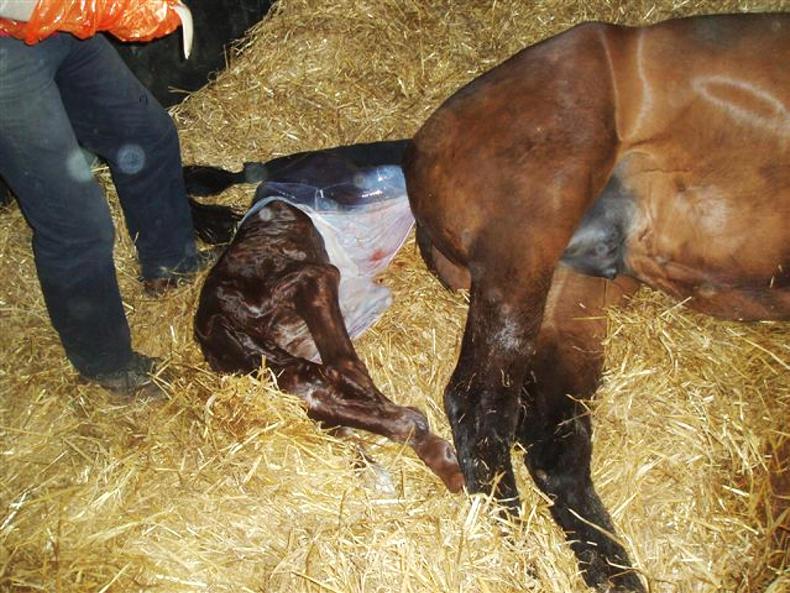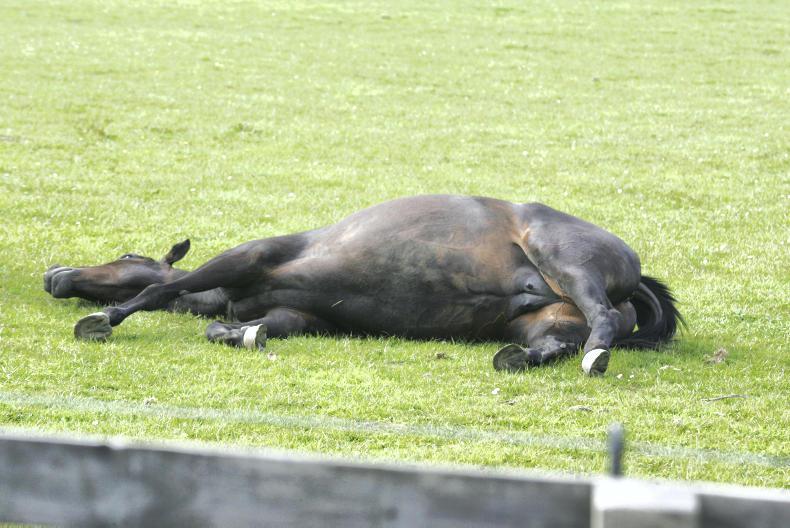STAGE 1
During the first stage of labour, uterine contractions begin and the foal in the uterus turns from lying on its back to lying on its stomach with its head between its two front legs.
The mare may start to show signs of restlessness, frequently getting up and down, urinating often, and sweating (acting colicky).
Stage one can last anywhere from 20 minutes to several hours.
It is important not to disturb the mare during this time, as she can postpone delivery of the foal if she feels nervous or uncomfortable. At the end of the first stage, the mare’s ‘water breaks’.
This is the releasing of the amniotic fluid, which appears straw coloured.
If present at this time, the mare’s tail should be wrapped and her vulva cleaned with warm water.
If you are planning to have your veterinarian present for the delivery, it is recommended that you call at this point.
STAGE 2

Once the amniotic fluid has been released, stage two of labour has begun.
The release of fluid at the beginning of stage two lubricates the mares vagina and triggers stronger contractions. This is when you might start to see the mare actively straining.
The mare might get up once or twice during this stage of labour, but usually is lying on her side to push.
Record keeping during this time is very important. The foal should be delivered within 30-40 minutes of the waters breaking or is in danger of dying.
The amniotic sac (which should be milky white in colour) will protrude first from the vulva as the contractions begin and the foal should present with its front feet, soles pointing down, covered in the amniotic sac. The front legs are usually presented one ahead of the other.
As the contractions continue, the head should be visible with the chin resting on the front legs. Now the mare will really begin to push and the shoulders, followed by the torso of the foal will be delivered, then the hips and hind legs.

The amnion usually ruptures when the shoulders are delivered.
Once the foal has been completely delivered, the mare should be resting. If the amnion around the foal was not ruptured during birth, you should gently open the sac and remove the membranes from around the foal’s nose and muzzle.
If the membranes were ruptured during foaling, the foal should be breathing comfortably and should begin to struggle to get off their side and into sternal recumbency (back facing upwards and abdomen facing down) within a few minutes of birth.
If the mare and foal are both resting comfortably and quietly, they should be left undisturbed.
Leaving the umbilical cord attached at this point can allow a substantial amount of blood to be transferred from the placenta to the foal. The mare will break the cord when she stands.
If at any time the delivery does not appear to be proceeding as normal, or more than 10 minutes passes with the mare straining and no sign of front feet or nose, notify your veterinarian immediately.
POTENTIAL PROBLEMS
Red bag
If instead of the milky white amnion presenting first, a red velvety membrane protrudes, this is a serious emergency, commonly referred to as a ‘red bag’ delivery. The foal is being deprived of oxygen – call your veterinarian immediately!
Dystocia
Dystocia or a difficult birth is where the foal is not presenting correctly. You might notice more than two feet protruding, the front feet presented without a nose, or too much time has passed without the feet being seen. If a difficult birth is occurring contact your veterinarian immediately.
STAGE 3

During the final stage, the placenta is passed. The placenta is usually passed within 30 minutes of delivery, and should be passed within three hours. If the membranes are retained any longer than four hours the risk of infection is high and veterinary assistance should be sought immediately.
In the meantime, the placenta should be tied up with twine to keep it from being stepped on or from becoming entangled in the mare’s hind legs. Once the placenta has been passed, remove it from the stall or paddock and place it in a bucket for your veterinarian to examine later.
Your veterinarian will examine the placenta to determine if all of it has been passed and also to determine if there is any evidence of infection within the placenta, which could put your foal at risk of becoming sick.
